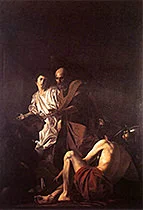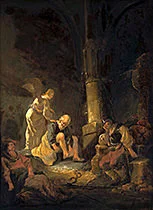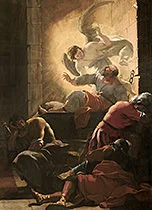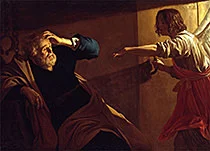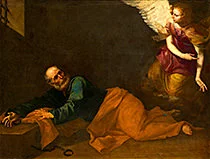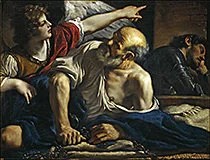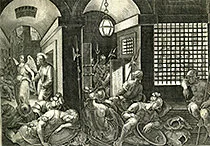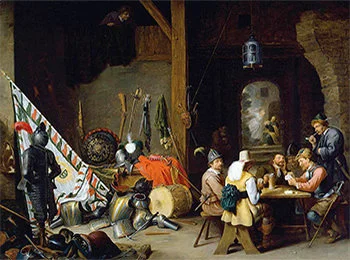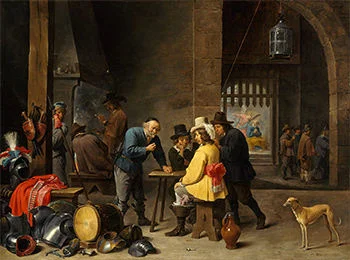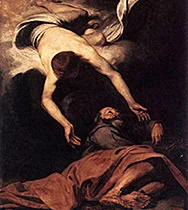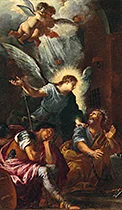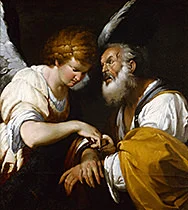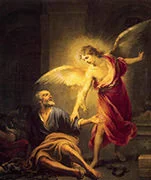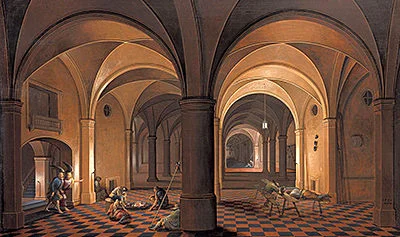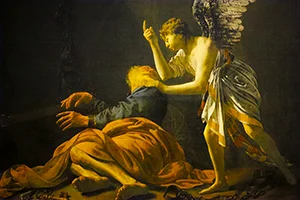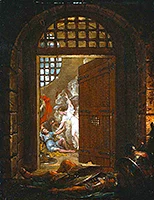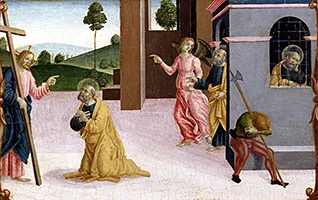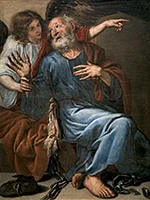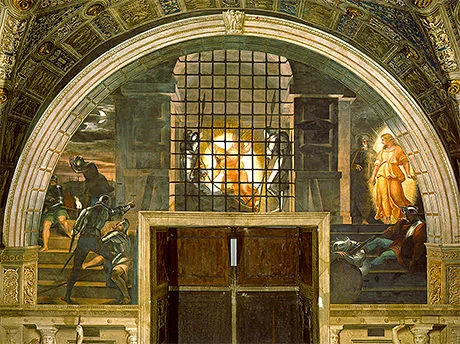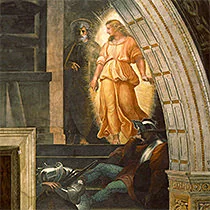The Art World Commemorates Peter
— Album 6 of 17 Photo Albums —
Warren Camp’s presentation of 550 famous “Peter” works of art includes historic paintings, frescoes, stained glass, etchings, sculptures, engravings, and other artwork monuments. They come from the Gothic (1100–1400), High Renaissance, Baroque, Rococo, Neoclassical, and Romantic (1800s) eras.
All are popular works, designed and created by celebrated artists, many of whom you’ll likely recognize, including Rembrandt, Raphael, Michelangelo, El Greco, Da Vinci, Masaccio, Huret, Galle, Tissot, Botticelli, Dürer, Rubens, and many more. They’ll bring back recollections of your “Art History 101” classes, using Janson’s History of Art textbook.
Whether depicting “Cephas,” “Petrus,” “Simon,” “Simeon,” “Simon Bar-Jonah,” “Simon Peter,” “The Rock,” “Peter,” “Apostle Peter,” or “Saint Peter,” the enlarged images of this acclaimed Bible figure come with factual and enlightening details: the artist’s bio; when each work was created; where it can be seen; applicable Bible passages; background and highlights of each work; and photo sources with copyright notices.
To appreciate the impact that Peter had on numerous art-world masters, be sure to click each thumbnail to enlarge it.
• These photo albums complement the Bible-study commentaries Warren has written for “1st and 2nd Peter,” found here.
…
Album 1 (Peter, alone) | Album 2 | Album 3 | Album 4 | Album 5
Album 6 | Album 7 | Album 8 | Album 9 | Album 10 | Album 11
Album 12 | Album 13 | Album 14 | Album 15 | Album 16 | Album 17
Album topics are shown at the [ ⇓ bottom ⇓ ] of each page.
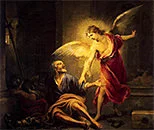
Peter Freed from Prison
from Prison by an Angel”
Slide 10
Click to enlarge.
Philip Galle
1550–1570
engraved print
from Prison by an Angel”
Slide 11
Click to enlarge.
Philip Galle
1550–1570
engraved print
Slide 13
Click to enlarge.
Mattheus van Helmont, 1650s, oil on panel
Slide 14
Click to enlarge.
David Teniers the Younger, 1645–1647, oil on wood
Slide 26
Click to enlarge.
Hendrick ter Brugghen follower
c. 1600 — oil on canvas
Slide 27
Click to enlarge.
Hendrick ter Brugghen
1629 — oil on canvas
Slide 29
Click to enlarge.
Vincenzo Frediani
1481–1505 — tempera on wood
Slide 31
Click to enlarge.
Jacopo di Cione, 1370–1371, tempera on wood
“Deliverance of Saint Peter”
Slide 33 — Click to enlarge and read its detailed caption.
Note the detailed triptych, below, of this “Deliverance of Saint Peter” masterpiece.
- 1. “Liberation of Saint Peter,” oil on canvas, painted by Giovanni Lanfranco, 1620–1621
Giovanni Lanfranco was born in Parma, Italy, in 1582. His talent for drawing allowed him to begin an apprenticeship with the Bolognese artist Agostino Carracci. He produced Baroque period paintings and altarpieces in Orvieto, Vallerano, Leonessa, and Fermo.
Lanfranco’s unfinished “Liberation of Saint Peter” oil-on-canvas painting depicts a biblical event that Luke recorded in Acts 12:6–7, wherein an angel frees or liberates Peter from prison. “He tapped Peter on the side and awakened him, saying ‘Quick, get up!’ (v. 7). The chains fell from Peter’s wrists. Look closely at the angel. How many additional arms do you see? . . . The extra not-yet-painted-out limbs provide a glimpse into the mind of the artist as he made changes on the canvas. The angel plays a pivotal role in this story; his left hand now touches Peter’s shoulder, which gives the image a feeling of immediacy.”[1]
“Acts 12:6–11 describes Peter’s angelic rescue from a Roman prison. Herod Agrippa I arrested and killed Apostle James, the brother of John. When he realized how much local religious leaders approved, he arrested Peter with plans to kill him after the Feast of Unleavened Bread. But an angel rescued Peter who said to himself, “Now I know without a doubt that the Lord has sent his angel and rescued me from Herod’s clutches and from everything the Jewish people were hoping would happen” (v. 11). Agrippa, grandson of Herod the Great and friend to the Pharisees, died likely a few days later of internal worms. Meanwhile, the church continued to grow”[2] … You can find details of Luke’s account of “Peter’s Miraculous Escape From Prison” in Acts 12:1–18.
… Height: 60.6 in. (153.9 cm), width: 48.1 in. (122.2 cm)
… Photo source, license, attribution, and museum details: Giovanni Lanfranco, public domain, via Wikimedia Commons
… The artist’s short biography; his other works of art
Return to “Peter Masterpieces” album’s opening page or to the top of this page or open the next album. - 2. “Liberation of St Peter,” oil on canvas, painted by Giovanni Battista Caracciolo, 1615
Liberation of St Peter “This picture was painted just after Giovanni Caracciolo came back from Rome; it’s his definitive masterpiece. It’s also one of the most fascinating and original interpretations of painter Caravaggio’s style. Of particular note is the splendidly classical figure of the angel who is about to take the hand of the frightened St Peter. Caracciolo understood Caravaggio’s art probably better than any other Caravaggist painter.”[1]
“Battistello Caracciolo — Neapolitan painter: One of the greatest of Caravaggio’s followers, Caracciolo’s powerful work was an important factor in making Naples a stronghold of the Caravaggesque style. The decisive impact that Caravaggio made on him can be seen in this ‘Liberation of St Peter’ (1615), painted on site at the Chiesa del Monte della Misericordia in Naples, where Caravaggio’s The Seven Acts of Mercy masterpiece painting can also be seen. This shows how Caracciolo, unlike so many of the Caravaggisti, looked beyond the obvious trademarks of Caravaggio’s work, aspiring to its depth of feeling, as well as its mastery of dramatic light and shade. In 1614, Battistello visited Rome; his later work is more classical in style, influenced perhaps by the Carracci family of Bolognese artists.”[2]
You can find details of Luke’s account of “Peter’s Miraculous Escape From Prison” in Acts 12:1–18.
… Height: 10.1 ft. (310 cm), width: 6.8 ft. (207 cm)
… Photo source, license, attribution, and museum details: Battistello Caracciolo, public domain, via Wikimedia Commons
… The artist’s short biography; his other works of art
Return to “Peter Masterpieces” album’s opening page or to the top of this page or open the next album. - 3. “Deliverance of St Peter,” oil on panel, painted by Benjamin Gerritsz Cuyp, c. 1635
The Deliverance of St Peter “The picture indicates the moment whereupon the angel awakened Peter, whereas the sentries are still in deep sleep. With a cluster fierce of light in the further quite dark space, Cuyp aimed all attention to Peter, making him the leading character. The liberation of Petrus was a popular theme in the Dutch art of seventeenth-century painting. Benjamin Cuyp painted this scene at least fifteen times.”[1]
“Benjamin Gerritsz. Cuyp (in full: Benjamin Gerritszoon Cuyp; Cuyp also spelled Cuijp; born December 1612, Dordrecht, Netherlands; died August 28, 1652, Dordrecht) was a Dutch artist who painted landscapes, genre scenes, battle pieces, and religious subjects in a Baroque style that appears to have been influenced by Rembrandt’s dramatic use of chiaroscuro. His nephew, Aelbert Cuyp, and his uncle, Jacob Gerritszoon Cuyp, were both noted painters.”[2]
The account of Peter’s liberation from prison by an angel of God has been recorded by Luke in Acts 12: “The night before Herod was to bring him to trial, Peter was sleeping between two soldiers, bound with two chains, and sentries stood guard at the entrance. Suddenly an angel of the Lord appeared and a light shone in the cell. He struck Peter on the side and woke him up. ‘Quick, get up!’ he said, and the chains fell off Peter’s wrists” (vv. 6–7). “Peter has been arrested by Roman soldiers; he has plenty of reasons to be nervous. At this moment, he’s fast asleep, chained at the wrists, guarded by four soldiers, two of whom surround him. Sleeping hard, the angel has to nudge him to wake him up and the chains fell off his wrists.”[3] You can find details of Luke’s account of “Peter’s Miraculous Escape From Prison” in Acts 12:1–18.
… Height: 36.4 in. (92.5 cm), width: 69.5 in. (207 cm)
… Photo source, license, attribution, and museum details: Benjamin Gerritsz Cuyp, public domain, via Wikimedia Commons
… The artist’s short biography; his other works of art
Return to “Peter Masterpieces” album’s opening page or to the top of this page or open the next album. - 4. “The Deliverance of Saint Peter,” oil on canvas, painted by Aubin Vouet, 1615
The Deliverance of St Peter by French painter Aubin Vouet (1595–1641) presents — on a very large canvas — the moment when an angel of God struck and awakened Peter while four prison guards remained sound asleep, despite the startling appearance of a bright light that shone in the otherwise dark cell. “Quick, get up!” the angel told Peter, as the chains immediately fell off Peter’s wrists. Peter’s liberation from prison has been a popular theme in the art world for several centuries. Note: Here in Warren Camp’s “Peter Masterpieces” photo Album 6 you’ll find at least thirty images of historic artwork highlighting Peter’s miraculous deliverance from prison.
In Acts 12, Luke has recorded the account of Peter’s liberation from prison, by an angel of God: “The night before Herod was to bring him to trial, Peter was sleeping between two soldiers, bound with two chains, and sentries stood guard at the entrance. Suddenly an angel of the Lord appeared and a light shone in the cell. He struck Peter on the side and woke him up. ‘Quick, get up!’ he said, and the chains fell off Peter’s wrists” (vv. 6–7). “Peter has been arrested by Roman soldiers; he has plenty of reasons to be nervous. It’s noteworthy that at this moment, he’s fast asleep, chained at the wrists, guarded by four soldiers, two of whom presently surround him. Sleeping hard enough, the angel has to nudge him to wake him up and the chains fell off his wrists.”[1] You can find details of Luke’s account of “Peter’s Miraculous Escape From Prison” in Acts 12:1–18.
… Height: 10.7 ft. (327 cm), width: 8.6 ft. (237 cm)
… Photo source, license, attribution, and museum details: Aubin Vouet, public domain, via Wikimedia Commons
… The artist’s short biography; his other works of art
Return to “Peter Masterpieces” album’s opening page or to the top of this page or open the next album. - 5. “The Angel Frees Peter from Prison,” oil on canvas, painted by Gerard [Gerrit] van Honthorst, c. 1617
The Angel Frees Peter from Prison “Our picture is the earliest known commission executed by [Dutch Golden Age] painter, Van Honthorst, in Rome. It was painted in 1616 to 1618 for art connoisseur and collector Marchese Vincenzo Giustiniani. In this composition, Van Honthorst reduced the account in the Acts of the Apostles (12:6–7) simply to the words ‘Quick, get up!’ with which the angel asked the astonished prisoner, Peter, to leave the gaol [jail] from the door that had burst open. The warriors and prison guards are left out, as are the chains that were said to have fallen from the prisoner’s hands. This early pictorial invention by him seems to have been generally hailed as a masterpiece and thus recurs in numerous replicas and copies.”[1]
Here’s the account of Peter’s miraculous release from imprisonment: “Peter was imprisoned in Jerusalem by Herod, to win the favor of the Jews, by throwing him into prison, intending ‘to bring him out for public trial’ (v. 4). Ardent prayer was offered by the Church for him: ‘Peter was kept in prison, but the church was earnestly praying to God for him’ (v. 5). Peter was miraculously liberated from prison by an angel while the guards lay sleeping (vv. 6–7). The angel told Peter, ‘Wrap your cloak around you and follow me’ (v. 8). Guided by the angel, Peter escaped from prison and regained his freedom. [Note: The psalmist declared: ‘The angel of the Lord encamps around those who fear him, and he delivers them’ (Psalm 34:7).] Freed and delivered Peter then proceeded from Jerusalem to Rome where he’d eventually endure martyrdom.”[2] You can find details of Luke’s account of “Peter’s Miraculous Escape From Prison” in Acts 12:1–18.
… Height: 50.7 in. (129 cm), width: 70.4 in. (179 cm)
… Photo source, license, attribution, and museum details: Gerard van Honthorst, public domain, via Wikimedia Commons
… The artist’s short biography; his other works of art
Return to “Peter Masterpieces” album’s opening page or to the top of this page or open the next album. - 6. “Liberation of Saint Peter,” oil on canvas, painted by Jusepe de Ribera, 1639
Liberation of Saint Peter “Born in provincial Spain by the end of his teens, Jusepe De Ribera studied art in Italy. After absorbing Raphael’s High Renaissance idealism and Caravaggio’s fashionable lighting, he settled in Naples, which was under Spanish rule during part of the 17th century.”[1]
Herein, “Saint Peter lies in prison where his sleep is interrupted by an angel who frees him. This subject allows De Ribera to create a work in which he can show the very best of his mature style. The work combines his naturalist style with strong chiaroscuro effects and with the warm palette that he used increasingly in the last years of the 1630s.”[2]
Read Luke’s account of Peter’s miraculous release from imprisonment: “Peter was imprisoned in Jerusalem by Herod, to win the favor of the Jews, by throwing him into prison, intending ‘to bring him out for public trial’ (v. 4). Ardent prayer was offered by the Church for him: ‘Peter was kept in prison, but the church was earnestly praying to God for him’ (v. 5). Peter was miraculously liberated from prison by an angel while the guards lay sleeping (vv. 6–7). The angel told Peter, ‘Wrap your cloak around you and follow me’ (v. 8). Guided by the angel, Peter escaped from prison and regained his freedom. [Note: The psalmist declared: ‘The angel of the Lord encamps around those who fear him, and he delivers them’ (Psalm 34:7).] Freed and delivered Peter then proceeded from Jerusalem to Rome where he’d eventually endure martyrdom.”[3] You can find details of Luke’s account of “Peter’s Miraculous Escape From Prison” in Acts 12:1–18.
… Height: 69.7 in. (177 cm), width: 91.4 in. (232 cm)
… Photo source, license, attribution, and museum details: Museo Nacional del Prado
… The artist’s short biography; his other works of art
Return to “Peter Masterpieces” album’s opening page or to the top of this page or open the next album. - 7. “The Liberation of Saint Peter,” oil on canvas, painted by Antonio de Bellis, early 1640s
The Liberation of Saint Peter “Antonio de Bellis (c. 1616 – c. 1656) was an Italian painter from Naples, active in the Baroque period. Along with Jusepe de Ribera, Bernardo Cavallino, and Massimo Stanzioni, he was one of the major artists working in Naples in the first half of the seventeenth century, under the influence of the painter Caravaggio.”[1]
We learn from Luke’s gospel text that “Peter was fast asleep, sitting in chains in a prison in Jerusalem, flanked by Roman soldiers. His execution was scheduled the next day and James had already been beheaded (Acts 12:1–2). When an angel awakened Peter and his chains fell off, he was likely dazed. In fact, he thought it a vision or a dream (v. 9).”[2]
Let’s put Luke’s account of Peter’s miraculous release from imprisonment into perspective: “Peter was imprisoned in Jerusalem by Herod, to win the favor of the Jews, by throwing him into prison, intending ‘to bring him out for public trial’ (v. 4). Ardent prayer was offered by the Church for him: ‘Peter was kept in prison, but the church was earnestly praying to God for him’ (v. 5). Peter was miraculously liberated from prison by an angel while the guards lay sleeping (vv. 6–7). The angel told Peter, ‘Quick, get up! . . . Wrap your cloak around you and follow me’ (vv. 7–8). Guided by the angel, Peter escaped from prison and regained his freedom. Freed and delivered Peter then proceeded from Jerusalem to Rome where he’d eventually endure martyrdom.”[3] You can find details of Luke’s story of “Peter’s Miraculous Escape From Prison” in Acts 12:1–18.
… Height: 70.2 in. (178.5 cm), width: 102.5 in. (260.5 cm)
… Photo source, license, attribution, and museum details: Antonio de Bellis, public domain, via Wikimedia Commons
… The artist’s short biography; his other works of art
Return to “Peter Masterpieces” album’s opening page or to the top of this page or open the next album.
- 8. “Saint Peter Freed by an Angel,” oil on canvas, painted by Guercino, c. 1622
Saint Peter Freed by an Angel “Giovanni Francesco Barbieri soon received the nickname ‘Il Guercino,’ owing to his squint (‘quercio’ in Italian means cross-eyed). He was chiefly self-taught in a particularly rich artistic environment by studying the altar paintings of Ludovico Carracci. He produced many paintings with the assistance of a large workshop, owing to the numerous commissions received from all over Italy and even from other countries.”[1]
“A youthful looking angel with curly hair imperiously points out the path of freedom to an astonished Saint Peter, depicted as a man of advanced age confined in a prison. In the background, clad in a suit of armour, the [jailer] sleeps, impervious to what is going on behind his back. The two main figures are attired in vaguely classical dress: the angel is simple but sumptuous, in accordance with her celestial nature and ideal beauty; [Peter] is draped in tattered clothing, owing to his precarious situation inside the dungeon. During the persecution of the apostles by Herod, when James [the brother of Apostle John] was executed, Peter was imprisoned; while he was asleep an angel appeared to him in his cell, telling him to stand up and flee, which he did without being discovered.”[2]
See Guercino’s red-chalk-on-paper drawing from the early 1650s that he titled “St Peter and the Angel.”
You can find Luke’s detailed account of “Peter’s Miraculous Escape From Prison” in Acts 12:1–18.
… Height: 41.3 in. (105 cm), width: 53.5 in. (136 cm)
… Photo source, license, attribution, and museum details: Museo Nacional del Prado
… The artist’s short biography; his other works of art
Return to “Peter Masterpieces” album’s opening page or to the top of this page or open the next album. - 9. “Saint Peter Being Released from Prison by the Angel,” etching print by Girolamo Pedrignani, 1650–1670
Saint Peter Being Released from Prison by the Angel After Herod Agrippa I arrested and killed Apostle James (Apostle John’s brother), he appreciated how much local religious leaders, especially the Sanhedrin, had approved of his powerful, political acts. He planned to do the Sanhedrin a favor that would ensure their goodwill by executing Peter, as he’d done to James. So he arrested Peter with plans to kill him the next day. Miraculously, Peter was freed and led out of prison by an angel. In the foreground, Italian etcher, Girolamo Pedrignani, presents three soldiers in their suit of armor, holding weapons, while asleep or in a daze. Placed in the footer of this print, Pedrignani attributed Pietro Testa as the artist whom this etching had followed.
We learn from Luke’s gospel text that “Peter was fast asleep, sitting in chains in a prison in Jerusalem, flanked by Roman soldiers. His execution was scheduled the next day and James had already been beheaded (Acts 12:1–2). When an angel awakened Peter and his chains fell off, he was likely dazed. In fact, he thought it a vision or a dream (v. 9). During his previous vision (10:9–16) of the sheet that lowered from heaven, filled with animals, and the voice that told Peter to kill and eat, he didn’t actually act on that command. This time, the angel has to tell him exactly what to do: Dress to fight or for flight, or, more literally, ‘Get dressed for action!’ The guards were coming to take Peter to his execution; he needed to move.”[1]
You can find Luke’s detailed account of “Peter’s Miraculous Escape From Prison” in Acts 12:1–18.
… Height: 12 3/16 in. (31 cm), width: 8 in. (20.3 cm)
… Photo source, license, attribution, and museum details: The Met; the Elisha Whittelsey Collection, the Elisha Whittelsey Fund, 1951
Return to “Peter Masterpieces” album’s opening page or to the top of this page or open the next album. - 10. “The Apostles Delivered from Prison by an Angel,” engraved print by Philip Galle, 1550–1570
Philip (or Philips) Galle, born in Haarlem, Netherlands (1537), was a Dutch draftsman, engraver, publisher, print dealer, writer, and historian. He’s especially known for his reproductive engravings of paintings. He also developed a style in his etchings that featured cross- and parallel-hatching that effectively produced shades of gray toward black. Galle’s practice gave his engravings a dark, silklike look.
“The Apostles Delivered from Prison by an Angel” (engraved by Galle after Maerten van Heemskerck): The apostles continually performed many signs and wonders among the people; more and more men and women believed in the Lord and were added to their number. Greatly moved by these miraculous healings, people brought the sick into the streets and laid them on beds and mats with the hope that at least Peter’s shadow might fall on some of them as he passed by. All of them were healed. As a result, the high priest and all his associates who were members of the Sadducees were filled with so much jealousy that they arrested the apostles and put them in the public jail. But, during the night, as Galle presents, an angel of the Lord opened the jail doors and safely brought them out, led by Peter.
The Bible reference that motivated Galle to create this detailed engraving of plate 10 is shown in the center of its footer: “Ac. Cap. 5.19” for Acts 5:19. You can read this miraculous healing passage titled “The Apostles Persecuted” in Acts 5:17–24.
… Height: 8 1/4 in. (210 mm), width: 10 2/3 in. (270 mm)
… Photo source, license, attribution, museum details, and image enlargement: National Gallery of Art; Ailsa Mellon Bruce Fund
… The artist’s short biography; his other works of art
… There are sixteen Galle engravings of Apostle Peter in “Peter Masterpieces”: Album 3 (3@); 5 (4@); 6 (2@); 7 (5@); 10; and 14.
Return to “Peter Masterpieces” album’s opening page or to the top of this page or open the next album.
- 11. “Saint Peter Delivered from Prison by an Angel,” engraved print by Philip Galle, 1550–1570
Philip (or Philips) Galle was a Dutch draftsman, engraver, publisher, print dealer, writer, and historian. Born in Haarlem, Netherlands (1537), he developed a style in his etchings that featured cross- and parallel-hatching that effectively produced shades of gray toward black, giving his engravings a dark, silklike look. He’s especially known for his reproductive engravings of paintings.
“Saint Peter Delivered from Prison by an Angel” (engraved after Jan van der Straet ): Galle shows Peter and an angel in two locations in this print: On the right behind bars and on the left, exiting the jail door. We learn from Luke’s gospel text that “Peter was fast asleep, sitting in chains in a prison in Jerusalem, flanked by Roman soldiers. His execution was scheduled the next day and James had already been beheaded (Acts 12:1–2). When an angel awakened Peter and his chains fell off, he was likely dazed. In fact, he thought it a vision or a dream (v. 9). During his previous vision (10:9–16) of the sheet that lowered from heaven, filled with animals, and the voice that told Peter to kill and eat, he didn’t actually act on that command. This time, the angel must tell him exactly what to do: Dress to fight or for flight; more literally, ‘Get dressed for action!’ The guards were coming to take Peter to his execution; he needed to move.”[2]
The Bible reference that motivated Galle to create this detailed engraving of plate 24 is shown in the center of its footer: “Acto. Cap. 12.6” for Acts 12:6. You can read this miraculous liberation passage titled “Peter’s Miraculous Escape From Prison” in Acts 12:1–18.
… Height: 8 1/4 in. (210 mm), width: 10 2/3 in. (270 mm)
… Photo source, license, attribution, museum details, and image enlargement: National Gallery of Art; Ailsa Mellon Bruce Fund
… The artist’s short biography; his other works of art
… There are sixteen Galle engravings of Apostle Peter in “Peter Masterpieces”: Album 3 (3@); 5 (4@); 6 (2@); 7 (5@); 10; and 14.
Return to “Peter Masterpieces” album’s opening page or to the top of this page or open the next album.
- 12. “Saint Peter Freed from Prison,” fresco, painted by Filippino Lippi, 1481
Filippino Lippi (1457–1504) was an Italian painter working in Florence, Italy, during the later years of the Early Renaissance and first few years of the High Renaissance. The scene above “is part of the fresco cycle depicting the story of Saint Peter’s life. It shows Peter being awoken by an angel and taken out of his cell, while the guard is sound asleep and notices nothing.”[1] Completing the cycle of frescoes in Florence’s Brancacci Chapel, painted by Masolino and Masaccio, a young Filippino Lippi painted this episode of Peter’s subsequent release from prison, miraculously made possible by the hand of an angel. [See closeup details of the faces of Peter and the angel.] The Brancacci Chapel was Lippi’s first major commission (1481–1485).
“Saint Peter Freed from Prison” Luke tells us in his gospel text that “Peter was fast asleep, sitting chained in a Jerusalem prison, flanked by Roman soldiers. His execution was scheduled the next day and James had already been beheaded (Acts 12:1–2). When an angel awakened Peter and his chains fell off, he was likely dazed. In fact, he thought it a vision or a dream (v. 9). During his previous vision (10:9–16) of the sheet that lowered from heaven, filled with animals, and the voice that told Peter to kill and eat, he didn’t actually act on that command. This time, the angel must tell him exactly what to do: Dress to fight or for flight; more literally, ‘Get dressed for action!’ The guards were coming to take Peter to his execution; he needed to move.”[2] You can read this miraculous liberation passage titled “Peter’s Miraculous Escape From Prison” in Acts 12:1–18.
… Height: 90.5 in. (230 cm), width: 34.6 in. (88 cm)
… Photo source, license, attribution, museum details, and image enlargement: Filippino Lippi, public domain, via Wikimedia Commons
… The artist’s short biography; his other works of art
Return to “Peter Masterpieces” album’s opening page or to the top of this page or open the next album. - 13. “The Liberation of Saint Peter,” oil on panel, Mattheus van Helmont, 1650s
Mattheus van Helmont (1623–after 1679) was “a Flemish painter who specialized in genre scenes of interiors and village scenes. His style and subject matter were influenced by the work of David Teniers the Younger and Adriaen Brouwer; his preferred subjects were peasant feasts, wedding celebrations, drinkers, and alchemists. He may have produced ‘guardroom scenes,’ i.e., scenes depicting an interior scene with officers and soldiers engaged in merrymaking.[1] Note: In July, 1997, this painting was sold at Christie’s in London for GBP 45,500 or $55,325.”[2]
The Liberation of Saint Peter “In this picture, the painter has relegated the miraculous episode from the life of Saint Peter to the background, focusing instead on the foreground in which sits a group of soldiers, reminiscent of the popular tavern scenes painted by Teniers, Brouwer, and others.”[3]
God demonstrated the power of prayer in Peter’s prison experience. After the apostle was seized by Herod’s men, thrown into prison, and then “guarded by four squads of four soldiers each” (Acts 12:4), his prospects looked bleak. But “the church was earnestly praying to God for him” (v. 5). They had Peter in their thoughts and prayers. What God did is simply miraculous! An angel appeared to Peter in prison, released him from his chains, and led him to safety beyond the prison gates (vv. 7–10). Although Helmont demoted Peter’s miraculous liberation from a prison cell by putting the angel and Peter into the background [right-center] of his detailed painting, you can read this passage titled “Peter’s Miraculous Escape From Prison” in Acts 12:1–18.
… Height: 24.4 in. (62 cm), width: 32.7 in. (83 cm)
… Photo source, license, attribution, museum details, and image enlargement: public domain, via Web Gallery of Art; private collection
… The artist’s short biography; his other works of art
Return to “Peter Masterpieces” album’s opening page or to the top of this page or open the next album.
- 14. “Guardroom with the Deliverance of Saint Peter,” oil on wood, painted by David Teniers the Younger, 1645–1647
David Teniers the Younger (David Teniers II; 1610–1690) was a Flemish Baroque painter, printmaker, draftsman, and art curator. “Flemish painters had a long tradition of relegating religious narratives to the background of scenes drawn from contemporary life. Here, the viewer can just glimpse Saint Peter’s liberation from captivity by an angel at the rear of a scene of military life. In the foreground, soldiers play dice and a heap of armor and earthenware convey Teniers’ skillful illusionism. In this way, the painting enacts the worldly distractions that can cause believers to lose sight of higher things.”[1]
Guardroom with the Deliverance of Saint Peter “The subject of the guardroom and its trappings (armor, weapons, drums) afforded Teniers ample opportunity to showcase his brilliance as a still-life painter.”[2] “The picture illustrates the deliverance of St Peter from prison. Teniers makes the scene more immediate by situating the story in his own time. This mundane scene is contrasted with the celestial vision of the angel urging the saint to escape through the open cell door (background-right). The exquisite costumes and interior, rendered in meticulous detail, add to the dramatic veracity of this Bible story.”[3]
Although Teniers the Younger followed the tradition of Flemish painters of demoting Peter’s miraculous liberation from a prison cell by putting the angel and Peter in the background of his detailed oil painting, you can read the actual passage titled “Peter’s Miraculous Escape From Prison” in Acts 12:1–18.
… Height: 21 3/4 in. (55.2 cm), width: 29 7/8 in. (75.9 cm)
… Photo source, license, and image enlargement: The Met; Gift of Edith Neuman de Végvár, in honor of her husband, Charles Neuman de Végvár, 1964
… The artist’s short biography; his other works of art
Return to “Peter Masterpieces” album’s opening page or to the top of this page or open the next album. - 15. “Saint Peter Freed from Prison,” oil on canvas, painted by Pier Francesco Mola, c. 1630
Pier Francesco Mola, called Il Ticinese (1612–1666): Born in Canton Ticino in Switzerland, he traveled to Rome as a boy when his father became an architect. Mola became a Swiss-Italian painter of the High Baroque. “In Rome he received public commissions for frescoes and altarpieces, fusing the Roman High Renaissance grandeur of Raphael and Michelangelo with the North-Italian color of Titian and Guercino. His most characteristic works were idyllic scenes with biblical figures or saints in luxuriant, dramatic landscapes that combine the golden light and painterly handling of Venetian art with figures inspired by Roman High Renaissance masters. Mola was also a versatile draftsman and a witty caricaturist.”[1]
Saint Peter Freed from Prison [“Some experts attribute this painting to Valentin de Boulogne.”][2] “Luke’s gospel text says that “Peter was fast asleep, sitting in chains in a Jerusalem prison, flanked by Roman soldiers. His execution was scheduled the next day and James had already been beheaded (Acts 12:1–2). When an angel awakened Peter and his chains fell off, he was dazed; he thought it a vision or a dream (v. 9). During his previous vision (10:9–16) of the sheet that lowered from heaven, filled with animals, and the voice that told Peter to kill and eat, he didn’t actually act on that command. This time, the angel has to tell him exactly what to do: Dress to fight or for flight, or, more literally, ‘Get dressed for action!’ The guards were coming to take Peter to his execution; he needed to move.”[3] You can read the entirety of this miraculous liberation passage titled “Peter’s Miraculous Escape From Prison” in Acts 12:1–18.
… Dimensions not provided
… Photo source, license, attribution, museum details, and image enlargement: Pier Francesco Mola, public domain, via Wikimedia Commons
… The artist’s short biography; his other works of art
Return to “Peter Masterpieces” album’s opening page or to the top of this page or open the next album. - 16. “Saint Peter’s Release from Prison,” oil on canvas, painted by Giovanni Ghisolfi, c. 1683
Saint Peter’s Release from Prison “Born about 1623 in Milan, Giovanni Ghisolfi, whose father was an architect who’d trained him in architectural painting, learned perspectival painting from his uncle, Paolo Antonio Volpini, and then settled in Rome in 1650 to study the ruins of the ancient city.”[1]
“The liberation of the apostle Peter is an event described in the Acts of the Apostles, chapter 12, in which the apostle Peter is rescued from prison by an angel. Although described in a short textual passage, the tale has given rise to theological discussions and has been the subject of a number of artworks. Luke says that Peter was put into prison by King Herod. But the night before Peter’s trial, an angel appeared to him and told him to leave. Peter’s chains fell off and he followed the angel out of prison, thinking it was a vision (v. 9). The prison doors opened of their own accord and the angel led Peter into the city. Eventually Peter described “how the Lord had brought him out of prison’ (v. 17). When his escape was discovered, Herod ordered the prison guards to be put to death.”[2]
Ghisolfi’s “Saint Peter’s Release from Prison” oil-on-canvas painting depicts numerous elements highlighted in Luke’s account: Peter (with his traditional keys), the open chains, a sleeping armed guard, and an angel amid a bright light who struck Peter to wake him up (vv. 6–7). He also added within celestial clouds cherubim magnifying the holiness and power of God. You can read the entirety of this miraculous liberation passage titled “Peter’s Miraculous Escape From Prison” in Acts 12:1–18.
… Dimensions not provided
… Photo source, license, attribution, museum details, and image enlargement: Giovanni Ghisolfi (1623–1683), Public domain, via Wikimedia Commons
… The artist’s short biography; his other works of art
Return to “Peter Masterpieces” album’s opening page or to the top of this page or open the next album. - 17. “The Release of Apostle Peter,” oil on canvas, painted by Sebastiano Ricci, 1710
“The Release of Apostle Peter” Sebastiano Ricci was “born in the Veneto and is considered a member of the Venetian School. But before he settled permanently in Venice in 1717, he led a peripatetic life, working in numerous Italian cities and also in England, Flanders, France, and Germany. He was the typical extrovert eighteenth-century virtuoso; as such his brilliance may appear somewhat superficial. But it needed precisely Ricci’s easy and versatile talent to steer Venetian art back to a new understanding of the great past, and forward towards the synthesis achieved in Tiepolo’s heroic style.”[1]
“The liberation of the apostle Peter is an event described in the Acts of the Apostles, chapter 12, wherein Apostle Peter is rescued from prison by an angel. Although described in a short textual passage, the tale has given rise to theological discussions and has been the subject of a number of artworks. Luke says that Peter was put into prison by King Herod. But the night before Peter’s trial, an angel appeared to him and told him to leave. Peter’s chains fell off and he followed the angel out of prison, thinking it was a vision (v. 9). The prison doors opened of their own accord and the angel led Peter into the city. Eventually Peter described “how the Lord had brought him out of prison’ (v. 17). When his escape was discovered, Herod ordered the prison guards to be put to death.”[2]
Ricci’s painting depicts numerous elements highlighted in Luke’s account: aged and bearded Peter, the open chains, sleeping armed guards, and an angel amid a bright light, urging Peter to get up (vv. 6–7)… You can read details of this miraculous liberation passage in Acts 12:1–18.
… Height: 9.9 ft. (300 cm), width: 6.6 ft. (200 cm)
… Photo source, license, attribution, museum details, and image enlargement: Sebastiano Ricci, public domain, via Wikimedia Commons
… The artist’s short biography; his other works of art
Return to “Peter Masterpieces” album’s opening page or to the top of this page or open the next album. - 18. “The Release of Saint Peter,” oil on canvas, painted by Bernardo Strozzi, c. 1635
“The Release of Saint Peter” Bernardo Strozzi, named il Cappuccino and il Prete Genovese was an Italian Baroque painter and engraver. “The [rosy-cheeked] angel delivering Peter from his bonds is depicted with the naturalism of an artisan going about a chore, while the saint himself is shown in glassy-eyed ecstasy — a favorite condition of Baroque painting. Strozzi divides his pigment into areas of flashy impasto and delicate glazing. Flesh, fabrics, feathers, and furry tufts of hair are indicated in brilliant passages of ‘alla prima’ painting.”[1]
“Acts 12:1–5 is the only Scripture that directly records the death of an apostle. Herod Agrippa I, who had commended himself to the Jewish leaders by protecting their religion, endeared himself further by arresting and beheading James, the brother of John. The Sanhedrin was so pleased by this that Agrippa arrested Peter, as well. He planned to kill Peter after the Feast of Unleavened Bread, but while Peter was chained and guarded by four squads of soldiers, ‘the church was earnestly praying to God for him’ (v. 5). In vv. 6–11, we read of Peter’s angelic rescue from a Roman prison. The church had been praying, however, and Peter’s ministry was not over. God answered their prayers by sending an angel to rescue him from prison.”[2]
Strozzi’s flashy impasto painting highlights not only the angel removing Peter’s wrist chains but, as we look into Peter’s eyes, we sense that “he had no idea that what the angel was doing was really happening; he thought he was seeing a vision” (v. 9)… Find details of this miraculous liberation passage in Acts 12:1–18.
… Height: 44.8 in. (114 cm), width: 49.4 in. (125.5 cm)
… Photo source, license, attribution, museum details, and image enlargement: Bernardo Strozzi, public domain, via Wikimedia Commons
… The artist’s short biography; his other works of art
Return to “Peter Masterpieces” album’s opening page or to the top of this page or open the next album. - 19. “The Liberation of Saint Peter,” oil on canvas, painted by Sebastiano Ricci, 1722
“The Liberation of Saint Peter” by Sebastiano Ricci “This sweeping, dynamic composition was part of the most important cycle of canvases commissioned in Venice in the first part of the eighteenth century. The cycle consisted of twelve pictures destined for the presbytery of the church of San Stae (its full name is Sant’Eustachio). Each picture was commissioned from a different artist, brought together at the same time, provoking comparisons between their various styles. Apart from Ricci, the group comprised among other major geniuses of eighteenth-century Venetian painting, Piazzetta, Pittoni, and Giambattista Tiepolo. Thanks to these commissions, San Stae became the most important experimental setting for Venetian art early that century.”[1]
It’s worth noting that “Acts 12:1–5 is the only Scripture that directly records the death of an apostle. Herod Agrippa I, who had commended himself to the Jewish leaders by protecting their religion, endeared himself further by arresting and beheading James, the brother of John. The Sanhedrin was so pleased by this that Agrippa arrested Peter, as well. He planned to kill Peter after the Feast of Unleavened Bread, but while Peter was chained and guarded by four squads of soldiers, ‘the church was earnestly praying to God for him’ (v. 5). In vv. 6–11, we read of Peter’s angelic rescue from a Roman prison. The church had been praying, however, and Peter’s ministry was not over. God answered their prayers by sending an angel to rescue him from prison.”[2]
This painting and Ricci’s other like-kind painting [see slide 17] highlight only the angel and Peter. In both it’s clear that “he had no idea that what the angel was doing was really happening; he thought he was seeing a vision” (v. 9)… Find details of this miraculous liberation passage in Acts 12:1–18.
… Dimensions not provided
… Photo source, license, attribution, museum details, and image enlargement: Sebastiano Ricci, public domain, via Wikimedia Commons
… The artist’s short biography; his other works of art
Return to “Peter Masterpieces” album’s opening page or to the top of this page or open the next album.
- 20. “Deliverance of St Peter from Prison,” bas-relief marble by Luca della Robbia, 1439
The Liberation of Saint Peter by Luca della Robbia (1440–1482) “The two bas-reliefs — ‘Deliverance of St Peter from Prison’ and ‘Crucifixion of St Peter’ — are all that remains of two marble altars commissioned from Luca in 1439 for the Tribune of San Zanobi. The reliefs clearly show the influence of Masaccio; the solid corporeality of the figures is reminiscent of Masaccio’s work in the Brancacci Chapel in Florence.”[1]
Did you know that “Acts 12:1–5 is the only Scripture that directly records the death of an apostle? Herod Agrippa I, who had commended himself to the Jewish leaders by protecting their religion, endeared himself further by arresting and beheading James, the brother of John. The Sanhedrin was so pleased by this that Agrippa arrested Peter, as well. He planned to kill Peter after the Feast of Unleavened Bread, but while Peter was chained and guarded by four squads of soldiers, ‘the church was earnestly praying to God for him’ (v. 5). In vv. 6–11, we read of Peter’s angelic rescue from a Roman prison. The church had been praying, however, and Peter’s ministry was not over. God answered their prayers by sending an angel to rescue him from prison.”[2]
Luca’s marble altar sculpture presents the angel and Peter leaving behind armed prison guards who remained fast asleep… In Acts 12:1–18 you can find details of this miraculous liberation passage.
… Height: 27.2 in. (69 cm), width: 30.7 in. (78 cm)
… Photo source, license, attribution, and enlargement: public domain, via Web Gallery of Art; Museo Nazionale del Bargello, Florence
… The artist’s short biography; his other works of art
Return to “Peter Masterpieces” album’s opening page or to the top of this page or open the next album. - 21. “The Liberation of Saint Peter,” tempera on panel, painted by Konrad Witz, 1443–1444
The Liberation of Saint Peter by Konrad Witz (c. 1400–1445) who was “a late-Gothic-Swiss painter, one of the first European artists to incorporate realistic landscapes into religious paintings.”[1] “The painting was a St Peter altarpiece panel, executed for the cathedral of Geneva, later dismembered.”[2]
Herod Agrippa I, who’d commended himself to the Jewish leaders by protecting their religion, endeared himself further by arresting and beheading James, John’s brother. The Sanhedrin was so pleased by this that Agrippa arrested Peter, as well. He planned to kill Peter the next day but, while Peter was chained and guarded by four squads of soldiers, ‘the church was earnestly praying to God for him’ (v. 5). In vv. 6–11, we read of Peter’s angelic rescue from a Roman prison. The church had been praying, however, and Peter’s ministry was not over. God answered their prayers by sending an angel to rescue him from prison.”[3]
“Unfortunately for Agrippa’s plans, the Lord miraculously brought an angel to Peter, released his chains, told him to dress for action, and led the groggy-eyed apostle out of the cell.”[4] Witz’s two-part tempera-on-panel painting presents: [right] the angel awakening Peter inside a Roman prison cell surrounded by armed guards; [left] the angel and haloed Peter leaving behind the guards as they escape (v. 10)… You can find details of this miraculous liberation passage in Acts 12:1–18.
… Height: 51.9 in. (132 cm), width: 60.6 in. (154 cm)
… Photo source, license, attribution, and image enlargement: public domain, via Web Gallery of Art; Musée d'Art et d'Histoire, Geneva
… The artist’s short biography; his other works of art
Return to “Peter Masterpieces” album’s opening page or to the top of this page or open the next album. - 22. “Liberation of Peter,” oil on canvas, painted by Bartolomé Esteban Murillo, 1665–1667
“Liberation of Peter” is a “1665–1667 oil-on-canvas painting by Bartolomé Esteban Murillo (1617–1682), depicting a scene of the liberation of Peter from Acts 12:5–17. It’s now in the Hermitage Museum in St Petersburg, Russia. Murillo is best known for his religious works.”[1]
The account of Peter’s liberation from prison by an angel of God has been recorded by Luke in Acts 12: “The night before Herod was to bring him to trial, Peter was sleeping between two soldiers, bound with two chains, and sentries stood guard at the entrance. Suddenly an angel of the Lord appeared and a light shone in the cell. He struck Peter on the side and woke him up. ‘Quick, get up!’ he said, and the chains fell off Peter’s wrists” (vv. 6–7). “Peter has been arrested by Roman soldiers; he has plenty of reasons to be nervous. It’s noteworthy that at this moment, he’s fast asleep, chained at the wrists, guarded by four soldiers, two of whom presently surround him. Sleeping hard enough, the angel has to nudge Peter to wake him up and the chains fell off his wrists.”[2]
Murillo’s painting depicts numerous elements highlighted in Luke’s account: aged and bearded Peter, the open arm and leg chains, fast-asleep armed guards, and an angel amid a bright light, urging Peter, “Quick, get up! … Wrap your cloak around you and follow me” (vv. 6–8)… In Acts 12:1–18 you can read details of this miraculous liberation passage.
… Height: 93.7 in. (238 cm), width: 102.4 in. (260 cm)
… Photo source, license, attribution, museum details, and image enlargement: Bartolomé Esteban Murillo, public domain, via Wikimedia Commons
… The artist’s short biography; his other works of art
Return to “Peter Masterpieces” album’s opening page or to the top of this page or open the next album. - 23. “The Release of Saint Peter from Prison,” oil on canvas, painted by Mattia Preti, c. 1665
“The Release of Saint Peter from Prison,” originally titled San Pietro Liberatodal Carcere “This large oil-on-canvas is a late work by Mattia Preti, from the period when he was active in Malta in the order of the Knights of Malta. It was certainly intended for a church.”[1] “Preti (1613–1699) was an Italian Baroque artist who worked in Italy and Malta. Probably before 1630, he joined his brother Gregorio (also a painter) in Rome, where he became familiar with the techniques of Caravaggio and his school, and the work of Guercino, Rubens, Guido Reni, and Giovanni Lanfranco.”[2]
Luke provides the account of Peter’s liberation from prison, by an angel of God, in Acts 12: “The night before Herod was to bring him to trial, Peter was sleeping between two soldiers, bound with two chains, and sentries stood guard at the entrance. Suddenly an angel of the Lord appeared and a light shone in the cell. He struck Peter on the side and woke him up. ‘Quick, get up!’ he said, and the chains fell off Peter’s wrists. Then the angel said to him, ‘Put on your clothes and sandals.’ And Peter did so. ‘Wrap your cloak around you and follow me,’ the angel told him. Peter followed him out of the prison, but he had no idea that what the angel was doing was really happening; he thought he was seeing a vision” (vv. 6–9).
Preti’s oil-on-canvas painting not only depicts numerous elements highlighted in Luke’s account, e.g., aged and bearded Peter, fast-asleep armed guards, and an angel, he also gave Peter a halo and traditionally put two keys in his hand… You can read details of this miraculous liberation passage in Acts 12:1–18.
… Height: 71.3 in. (181 cm), width: 118.5 in. (301 cm)
… Photo source, license, attribution, and enlargement: Mattia Preti - Akademie der bildenden Künste, Vienna, public domain, via Wikimedia Commons
… The artist’s short biography; his other works of art
Return to “Peter Masterpieces” album’s opening page or to the top of this page or open the next album. - 24. “Liberation of Saint Peter,” oil on panel, painted by Pieter Neeffs the Elder, 1637
“Liberation of Saint Peter” by Pieter Neeffs (or Neefs) the Elder (born c. 1578; died after 1656 but before 1661) who “was a Flemish painter who specialized in architectural interiors of churches. He also painted a few interiors of dungeons. Active in Antwerp, he was influenced by the works of the Dutch architectural painters Hendrik van Steenwijk the Elder and the Younger. His principal contribution to the genre were his nocturnal church interiors lit by two light sources; his compositions are characterized by their deeply receding spaces, created through the use of linear perspective and contrasting areas of light and dark.”[1] “The painting is signed and dated on the column in the right foreground: ‘1637 NEFS.’”[2]
Acts 12 shows this detailed account of Peter’s liberation from prison by an angel of God: “The night before Herod was to bring him to trial, Peter was sleeping between two soldiers, bound with two chains, and sentries stood guard at the entrance. Suddenly an angel of the Lord appeared and a light shone in the cell. He struck Peter on the side and woke him up. ‘Quick, get up!’ he said, and the chains fell off Peter’s wrists. Then the angel said to him, ‘Put on your clothes and sandals.’ And Peter did so. ‘Wrap your cloak around you and follow me,’ the angel told him. Peter followed him out of the prison, but he had no idea that what the angel was doing was really happening; he thought he was seeing a vision” (vv. 6–9).
Neeffs’ oil-on-panel painting uniquely depicts Peter and the angel (left) about to walk past several fast-asleep armed guards… You can read details of this miraculous liberation passage in Acts 12:1–18.
… Height: 17 in. (43.2 cm), width: 25.2 in. (64.2 cm)
… Photo source, license, attribution, museum details, and image enlargement: Pieter Neefs the Elder, public domain, via Wikimedia Commons
… The artist’s short biography; his other works of art
Return to “Peter Masterpieces” album’s opening page or to the top of this page or open the next album.
- 25. “Liberation of Saint Peter,” oil on canvas, painted by Hendrich ter Brugghen, 1624
Hendrick ter Brugghen was one of the most important of the Dutch followers of Caravaggio — the Utrecht Caravaggisti. “Along with Gerrit van Honthorst (Dutch, 1592–1656) and Dirck van Baburen (Dutch, c. 1595–1624), Ter Brugghen was instrumental in bringing the Italian artist’s radical, stylistic, and thematic ideas back to the Netherlands. He painted biblical and mythological scenes. Renowned for the boldness of his images and their subtle tonalities, Ter Brugghen’s broad style, markedly different from the detailed realism of most Dutch painting of his day, allowed him to create a sense of dignity and grandeur in his figures. Rubens admired these qualities when he visited him in Utrecht in 1627 and purportedly decreed that Ter Brugghen was the only ‘real painter’ he’d met in the Netherlands. His religious scenes resonated with Dutch artists, and his influence was felt widely in Utrecht and beyond.”[1]
On display at the Mauritshuis at The Hague, the museum curators tell us, “Ter Brugghen has painted the biblical story of St Peter’s liberation from prison. The angel is waking him and pointing upwards, as if to say that God has sent him. St Peter looks alarmed and folds his chained hands… Ter Brugghen created a very powerful painting with strong contrasts between light and dark and expressive facial expressions. He also showed the two figures very close up, copying this style from the Italian painter Caravaggio, whose work he’d seen in Rome.”[2] Note: Peter’s hands are clasped in a gesture of distress and prayer.
See Ter Brugghen’s later 1629 “Liberation of St Peter” rendition (slide 27) and his c. 1628 “The Denial of Saint Peter” painting in Album 15, slide 24.
… Height: 41 in. (104.5 cm), width: 34 in. (86.5 cm)
… Photo source, license, attribution, museum details, and image enlargement: Hendrick ter Brugghen, public domain, via Wikimedia Commons
… The artist’s short biography; his other works of art
Return to “Peter Masterpieces” album’s opening page or to the top of this page or open the next album. - 26. “The Liberation of St Peter,” oil on canvas, painted by a Hendrick ter Brugghen follower, c. 1600
This Liberation of St Peter depiction was taken from Luke’s account of the early ministry of the apostles, the book of Acts, relating to the miraculous liberation of Apostle Peter from prison. Herein, Peter was surprisingly visited by an angel, while two soldiers were sleeping in the background. It was first published as a work of the Dutch Caravaggist painter, Hendrick ter Brugghen. Although it typifies his trend of incorporating strong contrasts between light and shadow, scholars recently rejected the attribution to Ter Brugghen, assigning this work to an anonymous painter well acquainted with his style.
See Ter Brugghen’s actual “Liberation of Peter” renditions (slides 25 and 27) and his c. 1628 “The Denial of Saint Peter” painting (Album 15, slide 24).
In Acts 12, Luke has recorded the account of Peter’s liberation from prison by an angel of God: “The night before Herod was to bring him to trial, Peter was sleeping between two soldiers, bound with two chains, and sentries stood guard at the entrance. Suddenly an angel of the Lord appeared and a light shone in the cell. He struck Peter on the side and woke him up. ‘Quick, get up!’ he said, and the chains fell off Peter’s wrists” (vv. 6–7). “Peter has been arrested by Roman soldiers; he has plenty of reasons to be nervous. It’s noteworthy that at this moment, he’s fast asleep, chained at the wrists, guarded by four soldiers, two of whom presently surround him. Sleeping hard enough, the angel has to nudge him to wake him up and the chains fell off his wrists.”[1] You can read details of Peter’s miraculous escape from prison in this passage: Acts 12:1–18.
… Height: 54 in. (137.5 cm), width: 68 in. (172 cm)
… Photo source, license, attribution, and image enlargement: Follower of Hendrick ter Brugghen, public domain, via Wikimedia Commons
… The artist’s short biography; his other works of art
Return to “Peter Masterpieces” album’s opening page or to the top of this page or open the next album. - 27. “The Liberation of St Peter,” oil on canvas, painted by Hendrick ter Brugghen, 1629
Hendrick ter Brugghen (1588–1629) painted the subject of “The Liberation of Saint Peter” twice. While in the earlier 1624 version (see slide 25) he placed the dialogue between the angel and Peter in the foreground, in this later 1629 variation Ter Brugghen depicted the saint lying on the floor in a dark cell, with his dirty feet extended towards the viewer. Interestingly, in both compositions, the angel gestures upward towards God, who’d sent him to free Peter.
Dating from the last year of Ter Brugghen’s life, this large painting is an example of the monumentality and reduction of his late style. Concentrated solely on the two main protagonists, the dramatic event becomes a very quiet inner drama between the tacit angel and the old man who suddenly became confronted with the supernatural. See Ter Brugghen’s earlier 1624 “Liberation of St Peter” rendition: slide 25. Also see his c. 1628 “The Denial of Saint Peter” painting in Album 15, slide 24.
It’s worth noting that “Acts 12:1–5 is the only Scripture that directly records the death of an apostle. Herod Agrippa I, who had commended himself to the Jewish leaders by protecting their religion, endeared himself further by arresting and beheading James, the brother of John. The Sanhedrin was so pleased by this that Agrippa arrested Peter as well. He planned to kill him after the Feast of Unleavened Bread, but while Peter was chained and guarded by four squads of soldiers, ‘the church was earnestly praying to God for him’ (v. 5). In vv. 6–11, we read of Peter’s angelic rescue from a Roman prison. The church had been praying, however, and Peter’s ministry was not over. God answered their prayers by sending an angel to rescue him from prison.”[2]
… Height: 59 3/4 in. (152 cm), width: 82 2/3 in. (210 cm)
… Photo source, license, attribution, and image enlargement: Hendrick ter Brugghen, public domain, via Wikimedia Commons; photo by ArishG
… The artist’s short biography; his other works of art
Return to “Peter Masterpieces” album’s opening page or to the top of this page or open the next album.
- 28. “Saint Peter Released from Prison,” oil on paper on panel, painted by Benjamin West, 1800
Benjamin West (1738–1820) “was a British-American artist. Entirely self-taught, he soon gained valuable patronage and toured Europe, eventually settling in London. He impressed King George III and was largely responsible for the launch of the Royal Academy. West also painted religious subjects.”[1]
This Saint Peter Released from Prison artwork is an oil-on-paper painting that was mounted on a wooden panel. The supernatural liberation of Apostle Peter is an event described in Luke’s second volume, Acts, chapter 12. Therein, Peter gets rescued and liberated from a prison cell by an angel. You can read details of this miraculous liberation passage in Acts 12:1–18. King Herod arrested Peter and imprisoned him in the year 44, intending to execute him in a few days. But the entire church body of Jerusalem prayed to God “without ceasing” (v. 5) for his deliverance. God heard them and acted favorably. During the night, while chained between two guards, an angel appeared and broke the chains, telling Peter to follow him out of the prison. Miraculously, they left without waking the guards. Peter then went to the home of fellow disciples to let them know that he’d been freed from prison by an angel.
Among Benjamin West’s hundreds of religious paintings, you can see/enlarge/download these three classics that are highlighted in Warren Camp’s “Peter Masterpieces” photo album collection: “Saint Peter’s First Sermon in the City of Jerusalem” (Album 2, slide 18), “The Last Supper” (Album 12, slide 4), and “Saint Peter Denying Christ” (Album 15, slide 32).
… Height: 14.2 in. (36.1 cm), width: 11 in. (27.9 cm)
… Photo source, license, attribution, and image enlargement: Benjamin West, public domain, via Wikimedia Commons; Museum of Fine Arts, Boston
… The artist’s short biography; his other works of art
Return to “Peter Masterpieces” album’s opening page or to the top of this page or open the next album. - 29. “Saint Peter Released from Prison,” tempera on wood, painted by Vincenzo di Antonio Frediani, 1481–1505
Vincenzo Frediani (1476–1505) was active from 1481 until the year that he passed. He was known for a long time as the anonymous “Master of the Immaculate Conception,” on the basis of an altarpiece depicting that subject. Frediani was strongly influenced by three Florentine painters: Domenico Ghirlandaio, Filippino Lippi, and Sandro Botticelli. You can see samplings of their works here in Warren Camp’s “Peter Masterpieces” photo album: Ghirlandaio’s “Vocation of the First Apostles” (Album 2, slide 11) and “The Last Supper” (Album 12, slide 29); Lippi’s “Paul Visits Peter in Prison” (Album 3, slide 12), “Saint Peter Freed from Prison” (slide 12 of this album), and “Crucifixion of Peter,” (Album 16, slide 32); Botticelli’s “Lamentation Over the Dead Christ” (Album 3, slide 8).
“Saint Peter Released from Prison” is a small painting. It’s three-part, right-to-left scene presents haloed Saint Peter [right] looking out of a barred jail window. In the center, we see an angel with a pointed finger, directing Peter toward Jesus. And at the left, haloed Jesus, supporting a tall wooden cross, speaks attentively to Peter who, with his arms held over his heart, kneels before the Lord.
Frediani’s tempera-on-wood painting depicts two elements highlighted in Luke’s account plus a few surprises: Although we don’t see Peter’s traditional keys and open chains, we see a sleeping armed guard and an angel who leads Peter out of the prison (vv. 8–9). He also added a kneeling Peter, submitting himself humbly to Jesus who appears to get and hold Peter’s attention. You can read the entirety of this miraculous liberation passage in Acts 12:1–18.
… Height: 8 7/8 in. (22.5 cm), width: 13 3/4 in. (34.9 cm)
… Photo source, license, attribution, and image enlargement: public domain, via Art UK; photo by York Museums Trust
… The artist’s short biography; his other works of art
Return to “Peter Masterpieces” album’s opening page or to the top of this page or open the next album.
- 30. “St Peter Freed by an Angel,” oil on canvas, painted by Antonio de Pereda y Salgado, 1643
Saint Peter, Freed by an Angel was painted in 1643 by Antonio de Pereda y Salgado (c. 1611–1678), a Spanish Baroque-era painter. He was an excellent creator of compositions based on the Scriptures, especially the gospel. Such paintings were done for private oratories and church altars.
“Saint Peter is miraculously freed from prison in Jerusalem by an angel so that he can continue to evangelize. The chains and shackles lying open on the floor, and the angel pointing toward the exit, allow us to follow the action. The two figures are very much in the foreground and are adapted to the format of the canvas. They appear to be conversing. The angel’s youthful appearance contrasts with the aged and wrinkled skin of Saint Peter.”[1]
Here’s the actual account of Peter’s miraculous release from imprisonment: “Peter was imprisoned in Jerusalem by Herod, to win the favor of the Jews, by throwing him into prison, intending ‘to bring him out for public trial’ (v. 4). Ardent prayer was offered by the Church for him: ‘Peter was kept in prison, but the church was earnestly praying to God for him’ (v. 5). Peter was miraculously liberated from prison by an angel while the guards lay sleeping (vv. 6–7). The angel told Peter, ‘Wrap your cloak around you and follow me’ (v. 8). Guided by the angel, Peter escaped from prison and regained his freedom. [Note: The psalmist declared: ‘The angel of the Lord encamps around those who fear him, and he delivers them’ (Psalm 34:7).] Freed and delivered Peter then proceeded from Jerusalem to Rome where he’d eventually endure martyrdom.”[2] You can find details of Luke’s account of “Peter’s Miraculous Escape From Prison” in Acts 12:1–18.
… Height: 57 in. (145 cm), width: 43.3 in. (110 cm)
… Photo source, license, attribution, and image enlargement: Antonio de Pereda, public domain, via Wikimedia Commons
… The artist’s short biography; his other works of art
Return to “Peter Masterpieces” album’s opening page or to the top of this page or open the next album. - 31. “Saint Peter Liberated from Prison,” tempera on wood, painted by Jacopo di Cione 1370–1371
Jacopo di Cione (1325–1399) was an Italian Gothic-period painter in the Republic of Florence, Tuscany, Italy. The scene above represents “a small tempera-on-wood panel or predella [a step or platform] from a large polyptych (a multipanel altarpiece) painted in 1370–1371 for the no-longer-extant church of San Pier Maggiore in Florence, Italy. It is now part of the collection of the Philadelphia Museum of Art. This panel of the polyptych forms part of the narrative story of St Peter. Five additional predella panels of this San Pier Maggiore altarpiece still exist, dispersed in different collections, namely: The Arrest of St Peter at the Rhode Island School of Design Museum of Art, Providence; St Peter Raising the Son of Theophilus at the Vatican Pinacoteca; Chairing St Peter as Bishop of Antioch at the Vatican Pinacoteca; Last Meeting of Sts. Peter and Paul formerly part of Thyssen-Bornemisza and Sacerdoti Collections; and Crucifixion of St Peter at the Vatican Pinacoteca.
“Saint Peter Liberated from Prison” (also called “The Deliverance of Saint Peter”) “The [two-part] scene above depicts Peter’s liberation, an event from Acts 12:3–19 that says that he was put into prison in Jerusalem by King Herod. But the night before his trial, a light shone in the cell and an angel awoke Peter as he lay between two guards. Both the angel and Peter have saintly halos; the angel has golden hair; the soldiers wear semi-conical caps. Under the angel’s escort, Peter’s chains fall off as the gates open. The scene shows the angel awakening Peter inside the cell [left], leading him by the hand past sleeping guards [right]. Peter was initially incredulous, thinking that it was a dream. He exited the dark cell and entered a gilded world of freedom.”[1]
… Height: 15.4 in. (39 cm), width: 20.5 in. (52 cm)
… Photo source, license, attribution, and image enlargement: public domain, via Web Gallery of Art; Museum of Art, Philadelphia
… The artist’s short biography; his other works of art
Return to “Peter Masterpieces” album’s opening page or to the top of this page or open the next album. - 32. “The Liberation of St Peter,” oil on canvas, painted by Luca Giordano, 1661–1662
“The Liberation of Saint Peter” by Luca Giordano, an Italian late-Baroque painter, born in Naples and trained by Jusepe de Ribera, was known for his speed of painting. “Because he is said to have painted a large altarpiece in one day, it is no wonder that his output in oil and in fresco was enormous. His range of subject matter was equally great, although most of his pictures deal with religious or mythological themes.”[1]
In Giordano’s scene above, four armed prison guards on the right are fast asleep while the four on the left are beginning to wake. In the Baroque period, artists often referenced great historic art. Giordano’s masterpiece reveals his indebtedness to Raphael’s famous fresco with the same subject. This and the next slide’s painting (Raphael’s 1514 fresco titled “Deliverance of Saint Peter” in the Vatican’s Apostolic Palace) are very similar; they reflect focused motion. And Giordano’s gesture of the awakened soldier on the extreme left — is very similar to presentations of Renaissance masters. Similarly, both painters depicted the definitive liberating angel in the very center of their compositions, emphasizing the quintessence of the divine. Above, Giordano has unified the lower section of his large painting by featuring soldiers asleep, those about to awaken, and the one who’d already been awakened by the angel’s light.
The supernatural liberation of the apostle Peter is an event described in Luke’s second volume, Acts, chapter 12, in which Peter gets rescued and liberated from a prison cell by an angel. You can read details of this miraculous liberation passage in Acts 12:1–18.
… Height: 6.6 ft. (200 cm), width: 10.1 ft. (307 cm)
… Photo source, license, attribution, and image enlargement: public domain, via Web Gallery of Art; private collection
… The artist’s short biography; his other works of art
Return to “Peter Masterpieces” album’s opening page or to the top of this page or open the next album. - 33. “Deliverance of Saint Peter,” fresco painting by Raphael, 1514
Deliverance of Saint Peter “This is a fresco painting by the Italian High-Renaissance artist, Raphael [Raffaello Sanzio da Urbino]. Painted in 1514 as part of his commission to decorate with frescoes the rooms that are now known as the Stanze di Raffaello, in the Vatican’s Apostolic Palace, it shows how Saint Peter was liberated from Herod’s prison by an angel, as described in Acts 12. Technically, this is called an over-door or over-window painting.
“The fresco shows three scenes in symmetrical balance, formed by the feigned architecture and stairs. [Note: The technique of telling multiple aspects of a story within the same painting is called “continuous narrative.”] In the center the angel wakes Peter; on the right he guides him past the sleeping guards; on the left, one guard has apparently noticed the angel-generated light and wakes a comrade, pointing up to the miraculously illumined cell. This adds drama to the serene exit of Peter at the right.”[1] This Bible account offered Raphael an opportunity to demonstrate his skill as a painter of night scenes by contrasting the dungeon’s gloom with the angel’s blazing light, effectively emphasizing the divine character of this celestial apparition… Find details of this miraculous liberation passage in Acts 12:1–18. See video closeups of this and adjacent Vatican Museum frescoes painted by Raphael.
As noted in the previous slide’s caption, the two scenes depicted by Giordano and Raphael are very similar to one another as they reflect focused motion. Similarly, both painters portray the definitive liberating angel in the very center of their compositions, emphasizing the quintessence of the divine.
… Fresco width at base is 21.7 ft. (660 cm)
… Photo source, license, attribution, museum details, and image enlargement: Raphael, public domain, via Wikimedia Commons; this fresco’s detailed photos
… The artist’s short biography; his other works of art
Return to “Peter Masterpieces” album’s opening page or to the top of this page or open the next album.
- 34. Detail #1 of Raphael’s “Deliverance of Saint Peter” Fresco
A story unfolds and a miracle is performed…
Raphael breaks down this fresco’s “Deliverance of Saint Peter” story into three balanced episodes, taken from Luke’s recorded account in Acts chapter 12. Above, Detail 1 of this three-part fresco depiction shows the dismay of the guards as one soldier, whose armor appears to reflect the light of his torch, points upstairs and asks his three armor-clad, sleepy and puzzled comrades what’s happening inside the prison cell.
Deliverance of Saint Peter is one of many frescoes painted by Raphael (along with associates in his school) in the Vatican’s many museums. In particular, the four Raphael Rooms (Stanze di Raffaello, located on the third floor in the Palace of the Vatican) are famous for their frescoes, painted by Raphael and members of his large and complex workshop comprised of skilled collaborators who enabled him to realize numerous projects simultaneously. Along with Michelangelo’s ceiling art in the Sistine Chapel, these frescoes mark the High Renaissance in Rome.
God demonstrated the power of prayer in Peter’s prison experience. After the apostle was seized by Herod’s men, thrown into prison, and then “guarded by four squads of four soldiers each” (Acts 12:4), his prospects looked bleak. But “the church was earnestly praying to God for him” (v. 5). They had Peter in their thoughts and prayers. What God did is simply miraculous! An angel appeared to Peter in prison, released him from his chains, and led him to safety beyond the prison gates (vv. 7–10). This story is found only in vv. 1–18.
Return to “Peter Masterpieces” album’s opening page or to the top of this page or open the next album. - 35. Detail #2 of Raphael’s “Deliverance of Saint Peter” Fresco
A story unfolds and a miracle is performed…
The “Deliverance of Saint Peter” story in this fresco is broken down by Raphael into three balanced episodes, taken from Luke’s account that he recorded in Acts chapter 12. Above, Detail 2 of this three-part fresco depiction reveals the appearance of an angel of freedom inside Peter’s cell as he lies on the floor, chained to two armed soldiers.
Deliverance of Saint Peter is one of many frescoes painted by Raphael (along with associates in his school) in the Vatican’s many museums. In particular, the four Raphael Rooms (Stanze di Raffaello, located on the third floor in the Palace of the Vatican) are famous for its frescoes, painted by Raphael and members of his large and complex workshop comprised of skilled collaborators who enabled him to realize numerous projects simultaneously. Along with Michelangelo’s ceiling art in the Sistine Chapel, these frescoes mark the High Renaissance in Rome.
God demonstrated the power of prayer in Peter’s prison experience. After the apostle was seized by Herod’s men, thrown into prison, and then “guarded by four squads of four soldiers each” (Acts 12:4), his prospects looked bleak. But “the church was earnestly praying to God for him” (v. 5). They had Peter in their thoughts and prayers. What God did is simply miraculous! An angel appeared to Peter in prison, released him from his chains, and led him to safety beyond the prison gates (vv. 7–10). This story is found only in vv. 1–18.
Return to “Peter Masterpieces” album’s opening page or to the top of this page or open the next album. - 36. Detail #3 of Raphael’s “Deliverance of Saint Peter” Fresco
A story unfolds and a miracle is performed…
Raphael’s “Deliverance of Saint Peter” story in this fresco is broken down into three balanced episodes, taken from Luke’s account that he recorded in Acts chapter 12. Above, Detail 3 of this three-part fresco depiction presents a still-drowsy Peter, about to be led down stairs past two sleeping guards, while holding the reassuring hand of the divine liberator.
Deliverance of Saint Peter is one of many frescoes painted by Raphael (along with associates in his school) in the Vatican’s many museums. In particular, the four Raphael Rooms (Stanze di Raffaello, located on the third floor in the Palace of the Vatican) are famous for its frescoes, painted by Raphael and members of his large and complex workshop comprised of skilled collaborators who enabled him to realize numerous projects simultaneously. Along with Michelangelo’s ceiling art in the Sistine Chapel, these frescoes mark the High Renaissance in Rome.
God demonstrated the power of prayer in Peter’s prison experience. After the apostle was seized by Herod’s men, thrown into prison, and then “guarded by four squads of four soldiers each” (Acts 12:4), his prospects looked bleak. But “the church was earnestly praying to God for him” (v. 5). They had Peter in their thoughts and prayers. What God did is simply miraculous! An angel appeared to Peter in prison, released him from his chains, and led him to safety beyond the prison gates (vv. 7–10). This story is found only in vv. 1–18.
Return to “Peter Masterpieces” album’s opening page or to the top of this page or to the start of Warren Camp’s next page: Album 7.
“Peter” Has Indeed Left an Artistic Mark on Our World
In these albums, see numerous “Peter Masterpieces” created by renowned art masters from around the world.
• Album 1: “Peter, Alone” (29 images)
• Album 2: “Calling Apostle Peter” (12@), “Preaching the Gospel” (6@), and “Powerful Pentecost” (16@)
• Album 3: “Peter’s Presence with Other Apostles” (28@) and “Walking on Water” (7@)
• Album 4: “Receiving the Keys of Heaven” (15@), “Transfiguration” (8@), and “Tribute Money” (14@)
• Album 5: “Peter Heals People” (23@) and “The Miraculous Catch of Fish” (13@)
• Album 6: “Peter Gets Freed from Prison” (30@)
• Album 7: “Miscellaneous New Testament Depictions of Peter” (35@)
• Album 8: “Christ Washes Peter’s Feet” (26@)
• Album 9: “The Last Supper — Part 1” (33@ of 136)
• Album 10: “The Last Supper — Part 2” (35@ of 136)
• Album 11: “The Last Supper — Part 3” (34@ of 136)
• Album 12: “The Last Supper — Part 4” (34@ of 136)
• Album 13: “Christ’s Agony in the Garden” (32@)
• Album 14: “Judas’ Kiss,” “Jesus’ Betrayal,” and “Malchus’ Ear” (36@)
• Album 15: “Peter Denies Knowing Christ” (32@)
• Album 16: “Repentant Peter” (17@) and “Peter’s Martyrdom/Crucifixion” (17@)
• • • And, in Album 17, see “Stained Glass Windows Featuring Saint Peter” (34@)
Intro Videos: “First Peter” and “Second Peter”
† Watch this summary video of “First Peter” created by BibleProject.
† Here’s the “Second Peter” summary video created by BibleProject.
• Special Presentation: See more than sixty of Warren Camp’s “Peter Masterpieces” on this 4-minute video clip titled “Holy Week through 100 Paintings,” produced by Christian Art.

